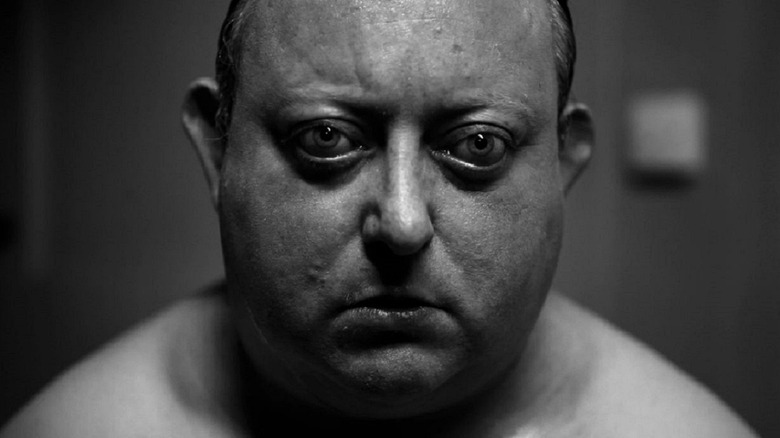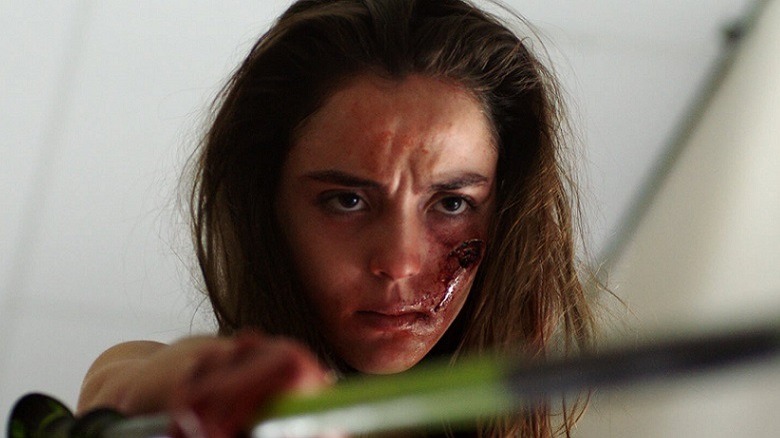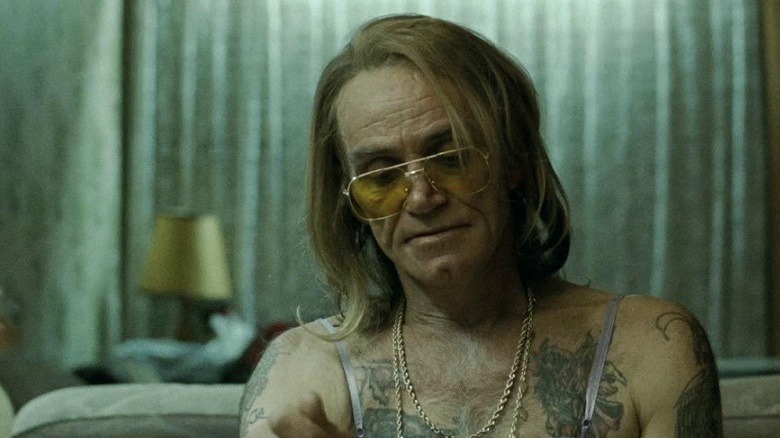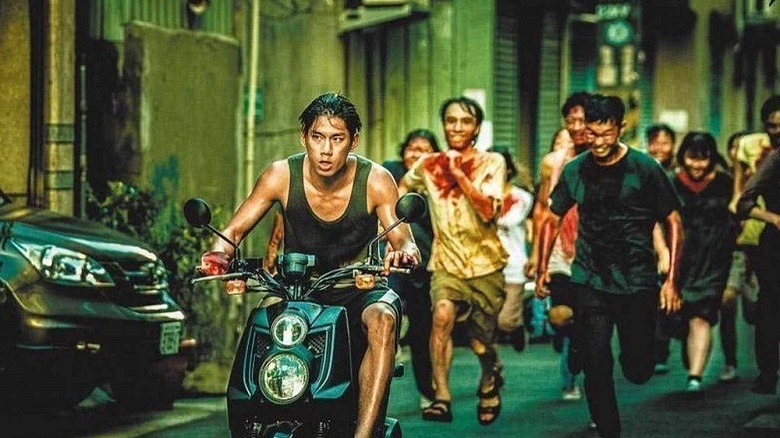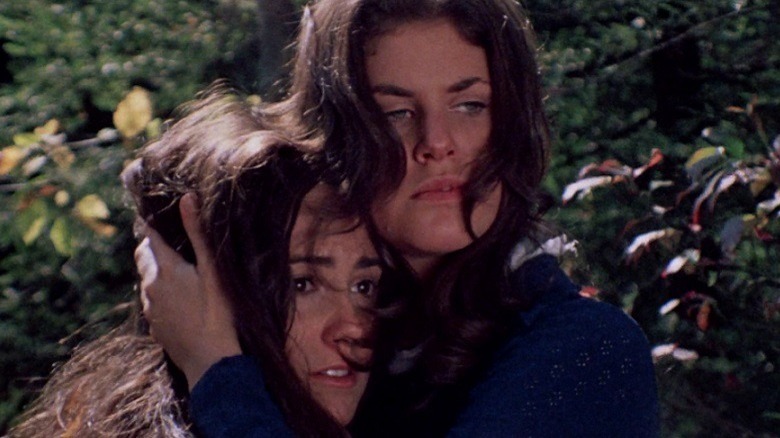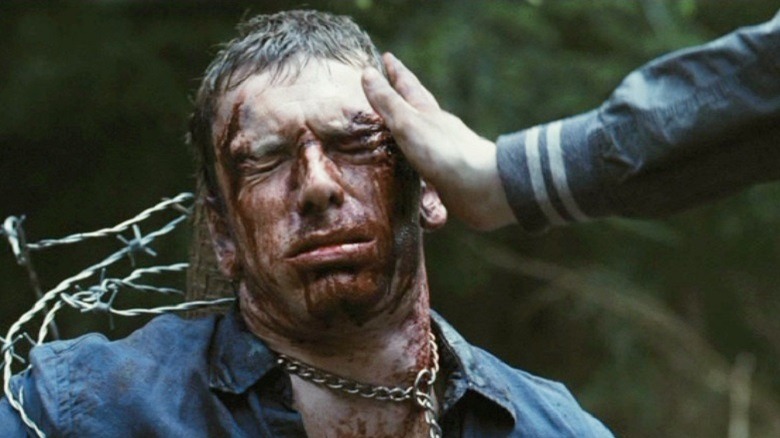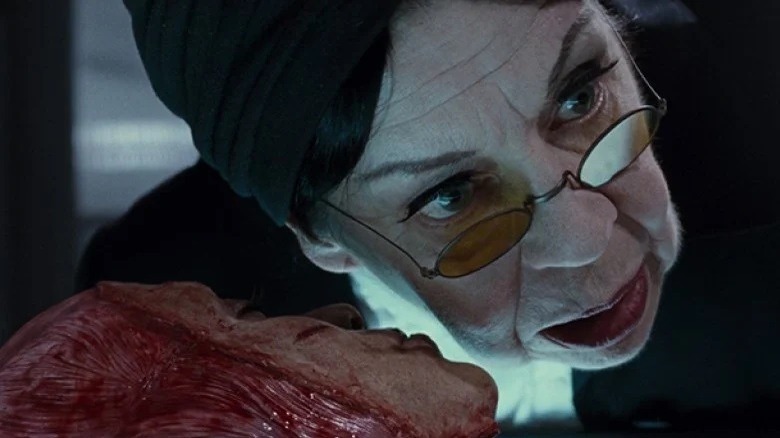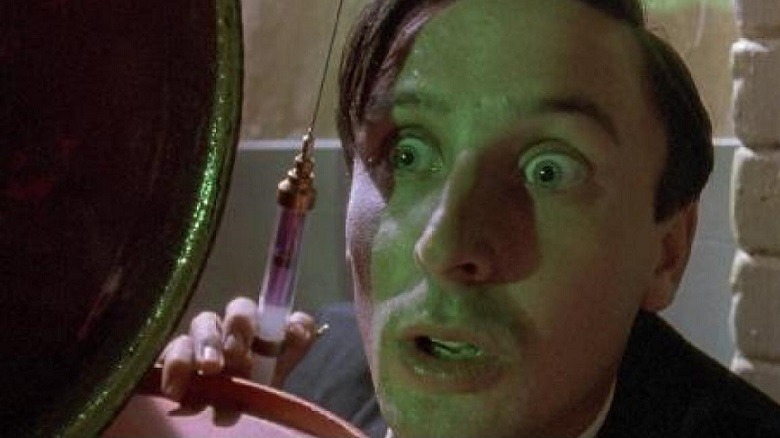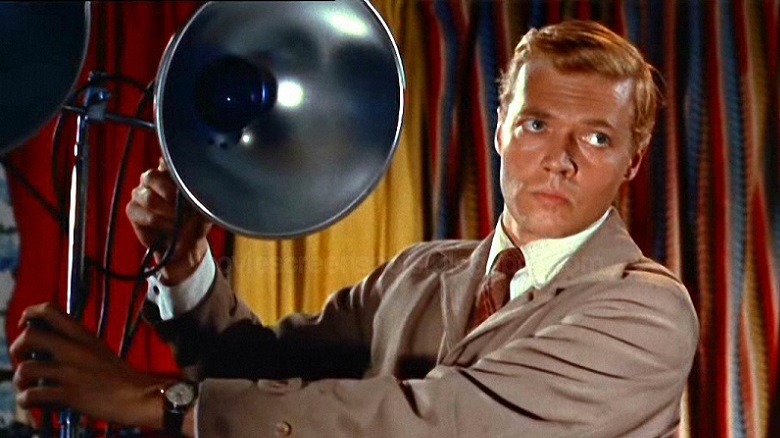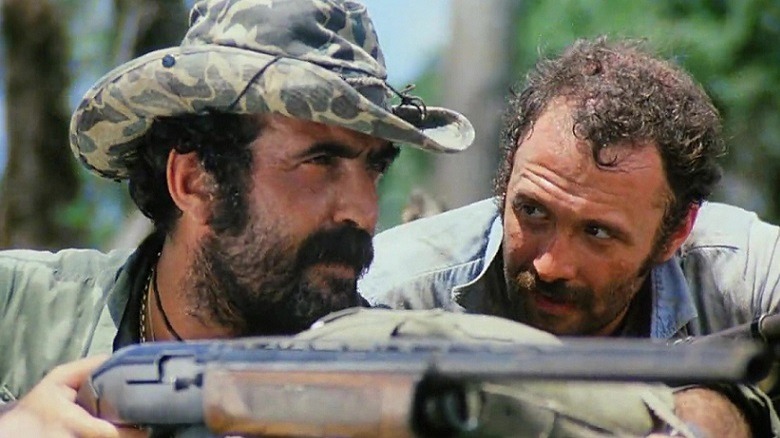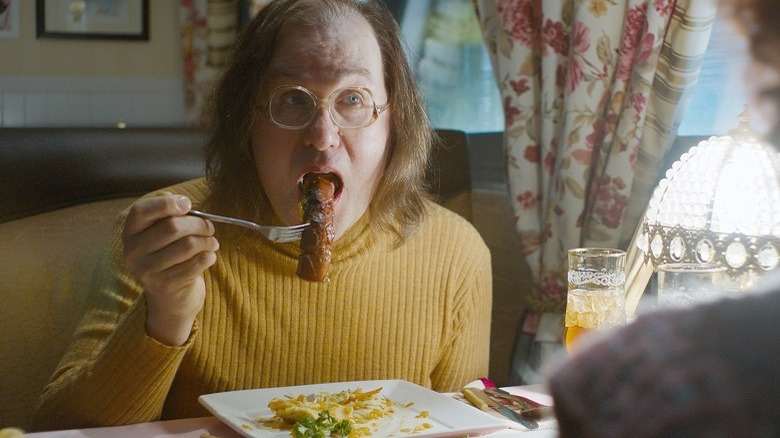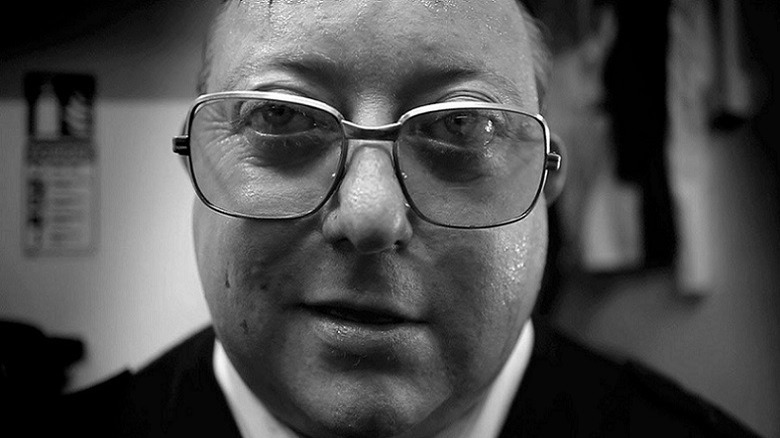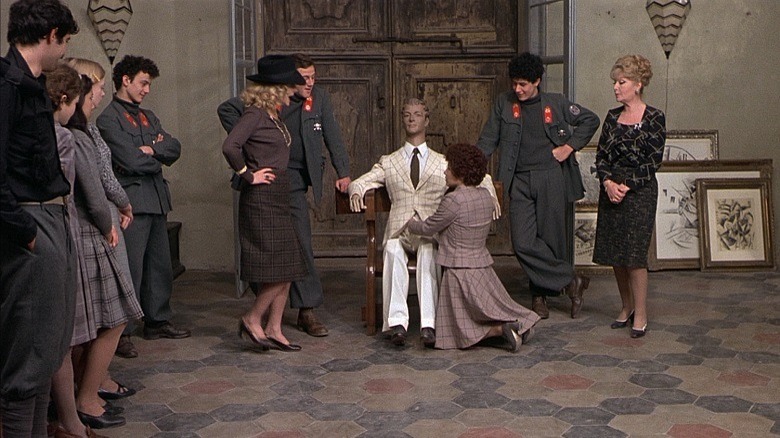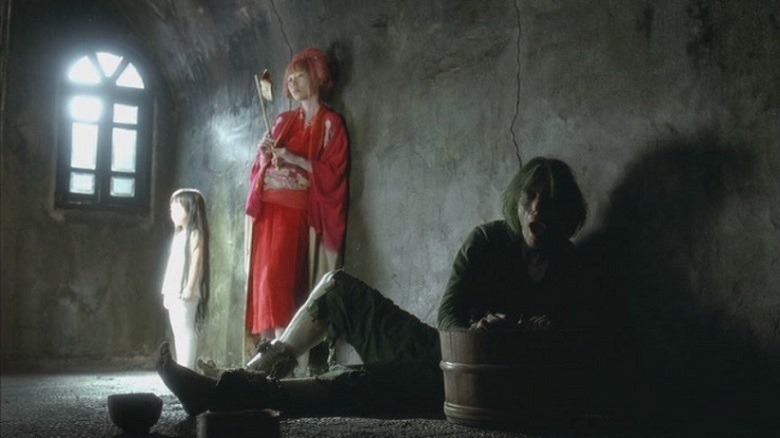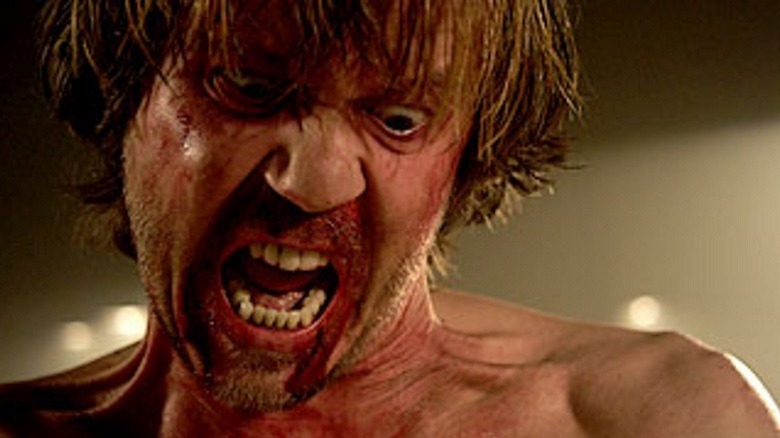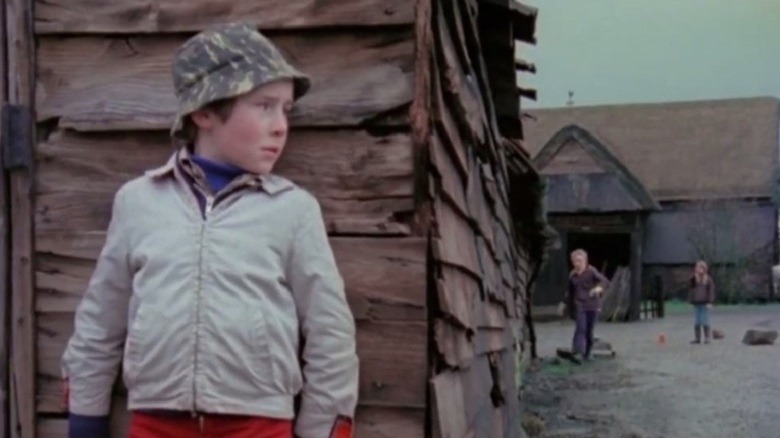15 Horror Movies That Went Too Far
Horror is custom-made to push boundaries and depict the extreme in order to elicit a visceral reaction from its audience. From the first jump scare of Count Orlok suddenly rising from his coffin in F.W. Murnau's 1922 silent classic "Nosferatu" to modern no-holds-barred effects fests in which computer-generated or practical effects are indistinguishable from reality, the genre constantly tries to outdo itself.
Whether it's extreme images presented for loyal gorehounds or the pushing of boundaries behind the scenes or matter-of-fact portrayal of man's worst excesses that seem too awful to be true, horror is a genre that expects you to be horrified by it — so it would have to go some way to truly shock you, right?
Here are 14 examples of cinematic horror taken too far in which even this most violent and unrestrained genre pushes itself over the boundaries of what is acceptable. Warning: There are many spoilers ahead.
Raw
The adage says, "You are what you eat", and nowhere is this taken more literally than in the 2016 New French Extremity coming-of-age movie "Raw." As part of a bizarre initiation ceremony for veterinary school, student Justine (Garance Marillier) is forced to eat raw meat for the very first time. Following that, she experiences bizarre cravings that push her beyond the boundaries of morality.
Cannibalism was an obsession with Italian filmmakers in the '70s and '80s, and it's still one of the biggest taboos in horror. Apart from the antics of cadaver connoisseur Hannibal Lecter, it's rarely depicted. "Raw" is unflinching in its portrayal of Thyestean activities, causing quite a stir at the 2016 Toronto film festival with viewers fainting at what was unfolding on screen.
However, there's a brilliantly subversive film beneath the controversy and obvious shock factor. Seasoned horror critics who could see past the gruesome imagery to the smart writing and black humor fared better than certain queasy Canadians, and the film met with considerable critical acclaim.
Snowtown
The Snowtown murders, named for the town in which eight corpses were found in barrels in a bank vault, were committed in South Australia in the '90s. The subsequent trial was one of the longest in Australian legal history. No film made about the sheer depravity of the crimes was ever going to be light-hearted or jovial, but audiences were unprepared for how downbeat and vicious the subsequent depiction would be.
"Snowtown" met with the ire of the victims' relatives, but the most shocking thing about the movie isn't any glorification of the murderers or their crimes, it's the matter-of-fact approach to the source material.
What is probably the most horrific thing about this film — and what will stick in your memory long after you've finished watching it — is how mundane it all is. Shot in a candid documentary style, the acts of brutality are awful because they're treated so casually. It's a film of evil people grooming others to do heinous acts. Ultimately, "Snowtown" is a bleak look at how awful humanity can be.
The Sadness
Chosen as the closing movie for the 22nd UK Frightfest horror festival, Rob Jabbaz's feature film debut "The Sadness" was a worthy conclusion to four days of horror.
In this Taiwanese film, a virus sweeps through the population. As COVID affected the global psyche, it was inevitable that the post-pandemic world would produce movies about infection, but "The Sadness" stands out because of its sheer brutality. It'd be too easy to use an already overdone theme and have the film's zombies depicted as the shambling undead, but the infected in the "The Sadness" are all too human — albeit preternaturally angry, unburdened by morality, and unleashed to fulfill their darkest and most monstrous desires.
It's a roller-coaster ride of unbridled gore and sadism — but with a beating black satirical heart. With its strong leads, "The Sadness" is as heartbreaking as it is jaw-dropping. How could the violence in a horror film go too far? If even a jaded Frightfest horror audience is stunned into silence by scenes you could never even imagine being filmed, you can only guess why.
The Last House on the Left (1972)
From his unique contribution to the slasher genre with "A Nightmare on Elm Street," to his subversive meta-approach to the genre in "New Nightmare" and "Scream," Wes Craven shaped modern horror as we know it. However, he was breaking boundaries back in the early seventies too, with a movie that nearly ended his career as soon as it had begun, with it being banned in multiple territories.
Two girls, Mari (Sandra Peabody) and Phyllis (Lucy Grantham), encounter recently escaped criminals and are subsequently tortured, abused, and ultimately killed by the feral foursome. Led by the sadist Krug Stillo (David Hess) (named for Craven's childhood bully, who would also act as the inspiration for flambéed fedora fiend Freddy Kreuger) the escapees are relentlessly brutal, making for discomforting viewing. Dreadful things happen to good people, and this film doesn't shy away from that.
In a cinematic era in which violence was still mostly implied, "The Last House on the Left" is an extreme attack on the senses. Even in the modern age of unflinching depictions of gore, the brazen attitude of Craven's debut still stands out as uniquely unforgiving and unyielding, and there is ultimately little sense of redemption or justice served as the closing credits roll.
Eden Lake
In "Eden Lake," Jenny (Kelly Reilly) and Steve (Michael Fassbender) are young, in love, and trying to have a romantic weekend. However, their tranquility is short-lived, as they find they're not alone. A group of youths is also there, and the couple runs afoul of them. Soon, anger explodes into bloody and cruel violence.
Featuring one of the earliest appearances of Michael Fassbender, "Eden Lake" is a brutal, gritty, visceral, and plausible take on class war from a genre that gave us the similarly themed (albeit geographically separated) "Deliverance" in 1972. Where it could be argued that the nihilistic "Eden Lake" goes too far — a point raised by many critics at the time — is in the movie's portrayal of the British working class.
Released during a period in which the working class was frequently demonized in the media, with the derogatory term "Chav" at its height of popularity in common vernacular, it's an unforgiving portrayal of blue-collar society in which the working class is depicted as monstrous sub-humans with few morals.
Martyrs
You should know what to expect from a genre called "New French Extremity," but "Martyrs" (the 2008 original, not the tamer 2016 US remake) is a movie only for the strong of stomach.
The plot synopsis reads as standard horror fare: Two mistreated girls invade the home of their abuser's family to finally gain revenge, but the machinations of the story are anything but conventional, covering such lofty concepts as survivor's guilt, theism, and secret religious sects. The storyline elevates it above the torture porn it could be mistaken for at face value, but that doesn't make viewing any more comfortable. Regardless of explicit content, it's a powerful and memorable piece of cinema.
Nearly given an 18 certificate in its native France — a virtual kiss of death for a film there — it took the French Society of Film Directors to campaign for the French Film Commission to re-evaluate their decision, claiming "this is the first time a French genre film has been threatened with such a rating." After the involvement of Christine Albanel, the French minister of culture, the movie was given a 16+ rating.
Braindead
Before Peter Jackson could be found poring over old Beatles footage or gallivanting around Middle Earth in "The Lord of the Rings," he was making low-budget horror movies.
"Braindead" (released as "Dead Alive" in North America, due to a clash of titles) is from that fine body of Jackson's early work. In this over-the-top zombie comedy, momma's boy Lionel (Timothy Balme) visits the zoo with his mother, Vera (Elizabeth Moody), who is bitten by a rare Sumatran Rat Monkey. When she dies and is resurrected as a zombie, Lionel's attempts to keep her condition hidden result in both farce and catastrophic bloodbath.
Its inclusion here isn't down to its extreme content. Indeed, it nearly received a lower certificate in the United Kingdom due to the slapstick nature of the comic-book violence. It's been subsequently out-blooded by the remake of "Evil Dead," but there's no denying that the last act of "Braindead" is utter carnage that resembles an explosion in an abattoir. It's believed that 300 liters of special effects blood were used, with a lawn mower plowing into a gang of shambling undead being a particularly hemoglobin-heavy highlight.
Peeping Tom
Derided in its day, modern slasher movies owe Michael Powell's "Peeping Tom" a huge debt. From its dark humor to the use of first-person perspective, putting us voyeuristically, in the killer's shoes, it contains many of the tropes commonplace in the genre.
Mark Lewis (Carl Boehm) works as a photographer in a film studio by day, but by night, he's making a documentary about fear, recording his victims' last moments as he murders them. Released two months before Hitchcock's equally controversial "Psycho," it would irrevocably damage Powell's career.
Hitchcock would weather the storm from the "Psycho" release. However, Powell, better known for classic British dramas such as "A Matter of Life and Death," was vilified by critics. Despite being a forerunner of a whole new genre, the movie was considered too violent and unpleasant for 1960s audiences.
Fortunately, after the rise of the slasher film in the 1970s, "Peeping Tom" saw subsequent re-appraisal and before his death in 1990, Powell saw his film rightfully come to be regarded as an influential masterpiece.
Cannibal Holocaust
A mainstay of exploitation cinema, "Cannibal Holocaust" is a very early example of a found footage movie. A documentary crew sent to the Amazon to film lost cannibal tribes goes missing, and their footage is retrieved by a rescue mission led by a renowned anthropologist. It's this footage that makes up the majority of the movie, showing sexual violence against women, inhumane treatment of animals, and of course, cannibalism.
This one doesn't make the cut because of its unpleasant subject matter, problematic misogyny, or its blatant racism — but because of its mistreatment of animals. Aside from the controversy of director Ruggero Deodato being falsely accused of murder, it's the shocking animal cruelty that makes "Cannibal Holocaust" such an unpleasant watch. There's brutal graphic documentary-style footage of a menagerie of jungle creatures killed for entertainment purposes. This abhorrent behavior rightly saw the director fined for animal cruelty.
The movie ends with the footage being burned, considered too extreme for viewing. Some may consider "Cannibal Holocaust" a candidate for the same treatment.
The Greasy Strangler
From the title alone, you know this isn't going to be a run-of-the-mill horror movie. The plot in this anarchic left-field work revolves around Brayden (Sky Elobar), the badgered son of an overbearing father, Ronnie (Michael St. Michaels). Their lives soon overlap with that of the titular "Greasy Strangler," a character whose appearance and raison d'être are made apparent from his very name.
The film's inclusion here is simply due to its unpleasant nature. From the filthy, squalid homes of the lead characters to the sordid and outlandish appearances and attitudes of the eccentric supporting characters, every frame of this remarkable film is tinged with griminess. One wash won't be enough to clean the grubbiness of this bizarre movie out of your system, which will linger with you like a permanent grease strain left by the eponymous throttler.
Eminently quotable and impossible to forget, "The Greasy Strangler" will force its way into your psyche. Accompanied by a thoroughly unnerving soundtrack, this film is as odd as it is disgusting, which is no mean feat.
The Human Centipede 2 (Full Sequence)
Director Tom Six could hardly have been accused of restraint in 2009's "The Human Centipede," an everyday tale of boy meets girls, boy gets surgically affixed to girls, but that movie pales compared to its first sequel. Despite the outlandish concept, the first film is basically the old cinematic trope of mad-scientist-run amok. It's unpleasant and hard to stomach (no pun intended) but is hard to take seriously.
With meta-contextualization rivaling 2000's "Blair Witch 2," this sequel follows Martin (Laurence R. Harvey), an individual so obsessed with the first "Human Centipede" film that he plans to replicate it in real life. Shot in black and white, "The Human Centipede 2 (Full Sequence)" is so gritty and unpleasant that you'll have to shower afterward. That was a view shared by the British Board of Film Classification, which saw fit to reject giving it a certificate. They deemed it so beyond redemption, that no cuts could make it releasable. Of course, the filmmakers exploited this controversial move, using the BBFC's comments in advertising: "Banned in the UK; Poses a real risk that harm is likely to be caused to potential viewers."
Salò, or the 120 Days of Sodom
It probably comes as no great surprise to "Salò, or the 120 Days of Sodom," a movie inspired by the unfinished 1785 novel "120 Days of Sodom" by the Marquis De Sade. A horror art film by controversial director Pier Paolo Pasolini, it follows four aristocrats who kidnap 18 teenagers and spend four months abusing and debasing them.
It's probably easier to recite the places where "Salò" hasn't been banned, either temporarily or to this day. It's telling that the most conventional thing about this 116-minute film is the Ennio Morricone soundtrack. Exploring themes of class, dominance, and control, it's also one of the few films, along with John Waters' "Pink Flamingos," to feature coprophagia.
Run over several times by his own car, Pasolini died three weeks before the film premiered, so he didn't see any of the ensuing controversy regarding the film. There's a certain level of amusement to be had in the argument that a film a half-century old based on source material more than two centuries old can still be considered too shocking.
Masters of Horror: Imprint
Each segment created by a genre expert, "Masters of Horror" was an anthology series that ran from 2005 to 2007. "Imprint," the intended 13th episode of Season 1, was directed by Takashi Miike, a man who is no stranger to filming extreme violence.
Set in 19th century Japan, "Imprint" sees an American journalist (Billy Drago) return to the country to find the sex worker he fell for but learns of the cruel fate and the supernatural shenanigans that befell her in his absence.
Like most anthology series, each episode of "Masters of Horror" varied in plot and theme. However, in "Imprint," the series went a step too far. It was due to air in 2006 but the host network, Showtime, thought it too disturbing due to its depictions of torture. Despite edits from show-runner Mick Garris, the episode was canceled. To this day, it is still the only one of 26 episodes not to have aired in the United States.
A Serbian Film
With even the Wikipedia plot synopsis disturbing enough to put off all but the boldest of horror fans, "A Serbian Film" remains as contentious now as the day it was released. Banned in 46 countries, it tells the tale of Miloš, a retired porn star who agrees to appear in one final film before he takes a permanent break from the industry. However, he finds that the movie he's agreed to be in will push the boundaries of what is acceptable or moral.
Dubbed by many critics as a thoroughly repugnant film, it's intended as a metaphor for modern-day Serbia — and is partly exploiting the fact that Serbia has no motion picture rating system. Hence, there were no regulations that would have prevented its production.
That said, censorship around the world would prevent it being shown. Banned in many territories and radically cut in others, it remains a great source of controversy to this day.
Honorable Mention: Apaches
Not officially a horror film but terrifying enough to scare an entire generation of British Gen-X children, "Apaches" is a short film made by the Central Office of Information. Following a group of children and their playtime exploits on and around a local farm, it shows the dangers of rural life. All but one of the children meet grisly ends: crushed by a tractor or falling gate, drowning in a slurry pit, or poisoned by ingesting chemicals.
Shown in schools as a public information film, it was directed by John Mackenzie of "The Long Good Friday" fame and was just as harrowing as anything in that adult gangster movie. Like many of the films produced by the COI, it was designed to educate through fear, and it did just that to the extent that any Brit over the age of 50 going anywhere near a farm is likely to suffer post-traumatic stress disorder.
